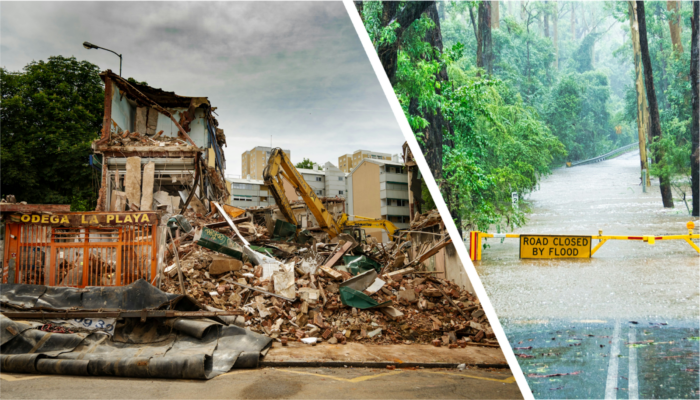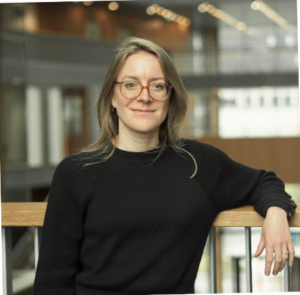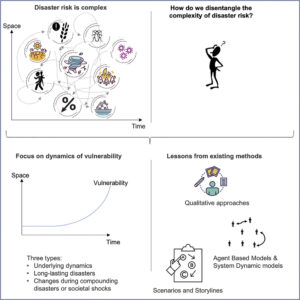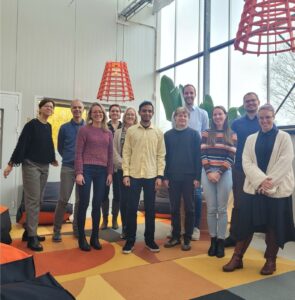

Marleen de Ruiter is Assistant Professor at the Institute for Environmental Studies (IVM), Vrije Universiteit Amsterdam. Her research focuses on multi- and consecutive disasters, improving modeling capabilities and understanding of multi-hazard risk and assessing the potential adverse impacts of Disaster Risk Reduction measures across different hazards. She manages the Myriad-EU project, co-leads the RiskKAN working group on early warning systems for systemic risk, and has recently received a four-year personal grant from the Dutch Research Council to work on the global occurrence of consecutive disasters followed by water-borne disease outbreaks. Marleen has been awarded NH Division Outstanding Early Career Scientist for 2024. In this inspiring interview, she shares the challenges and opportunities of investigating the complexity of multi-(hazard-)risks.
Hi Marleen! Thank you for taking the time to answer my questions today. First and foremost, congratulations on your well-deserved award. Your contributions to the field of multi-(hazard-)risks are truly inspiring to me and many other early career scientists.
Can you tell us more about your background and experience in multi-(hazard-)risks? What initially sparked your interest in this field, and how has your passion evolved?
I enjoy the fact that the multi-hazard risk field brings together a wide array of people. While confident in our one area of expertise, we all may feel a bit of a fledgling on another part of the research. This field of research, though, is powered forward by the collective efforts of diverse individuals and teams from around the world. This means that I always get to work in very interdisciplinary teams with people from very different backgrounds, and since there is still so much to uncover, we never stop learning.
In a way, I have been engaging with this idea of collaborative learning since my first professional chapter in Canada. When I lived in Vancouver (and later Iran), I worked as a risk manager specialising in earthquake risk. Through this work, I realised that oftentimes, a place isn’t facing the threat of only that one hazard but several. When I returned to Amsterdam and joined the IVM’s Water and Climate Risk group for my PhD, working with Prof. Jeroen Aerts and Prof. Philip Ward, I wanted to combine my professional experience with their research expertise. We decided to conduct a cross-disciplinary study comparing how researchers in the fields of flood risk versus earthquake risk assess vulnerability [1]. This exciting research exposed the differences ingrained within these hazard topics and in turn, was the starting point of my intrigue with multi-hazard risk.
A year later, when I wanted to submit an abstract about this paper to EGU, I noticed that there wasn’t a multi-hazard risk session. Encouraged by colleague Dr Hans de Moel, I proposed a session on this topic with others who had already been working longer on the topic of multi-risk, such as James Daniell. Our session, as proposed, unfortunately, didn’t receive enough abstracts in that first year. Fortunately, though, neither did Jakob Scheizschler’s session on compound events. Looking back, our decision to merge our sessions reflected the recent increased interest in the fields of compound and multi-risk.
It has been very interesting to see how the compound and multi-risk fields have taken their own paths of development. In the past year, though, several efforts have been made to bring these paths back together and learn from each other. Looking at the compound field, huge advances have been made to improve (hazard) modeling capabilities, while the multi-risk field focused on including not only climate-related hazards but also geophysical hazards, as well as developing frameworks that support our thinking [e.g., 2, 3, 4, 5] and the development of multi-risk models. This may in part be due to the complexity of trying to encapsulate all the different feedbacks and dynamics of multi-risk (as opposed to multi-hazards). But as I mentioned before, we never stop learning.
[Editor’s note: Multi-risk is the term used to refer to the risk generated from multiple hazards and the interrelationships between these hazards (and considering interrelationships on the vulnerability level). Compound weather and climate events refer to combinations of multiple weather and climate drivers and/or hazards that lead to potentially large impacts.]

The challenges of dynamic vulnerability and how to assess it (Graphical abstract) [3]
From your perspective, what are some of the most pressing challenges facing the field today, and what could be the role of interdisciplinary collaboration to address them?
From a research perspective, one of the key challenges is to identify and then subsequently quantify the spatial and temporal dynamics and feedbacks of multi-(hazard) risk. The former requires a very thorough understanding of a system which necessitates teamwork between scientists and local stakeholders, while the latter requires a myriad of detailed data analyses.
This is an incredibly complex task, as the more abstract elements of risk (e.g., vulnerability) are difficult to include. Many have therefore tried to break down the problem into smaller pieces, and I think this is something that the compound field has done very well (for example, focusing on two (drivers of) hazards for a specific region). The hazard component of risk is also typically the part of risk that has the best data available. One way forward for the multi-risk field is now to learn lessons from the methodological advances made in the compound field and test which ones can be of use to assess other dynamics of multi-risk.
Regarding valorisation, multi-risk scientists need to make a concerted effort to better communicate the challenges and urgency of deeper understanding and addressing multi-risk in the communities of practitioners and policymakers. In reality, there needs to be a dialogue as local practitioners and policymakers will better understand the (complexity of the) local system.
In your research, how do you account for uncertainties and dynamic changes in multi-risk assessments, particularly in the context of climate change, urbanization, and demographic pressure?
I think your question sums up some of the key challenges we are facing! As mentioned before, instead of trying to address all complexities at once, we try to focus on smaller topics and tasks in a step-by-step approach. This is what we have done thus far in the MYRIAD-EU project: for example, Judith Claassen developed a method to generate multi-hazard event sets [6], while Tristial Stolte is working on the dynamics of vulnerability for urban areas. I am working with Robert Sakic Trogrlic on a disaster forensics study trying to obtain lessons from 100 case studies around the world to assess challenges for Disaster Risk Management in the context of multi-hazard risk. One day soon, we will be able to bring all these elements together.
In your opinion, what could be the role of some emerging trends or technologies, such as AI, in revolutionizing the multi-risk assessment and management field?
I think we need to be careful; there is a lot of potential, but we lose out on the human perspective and an understanding of what is happening “in the black box”.
Can you share any examples of successful multi-(hazard-)risk tools, strategies, or initiatives you’ve been involved in?
This makes me wonder what a successful strategy is. Is success a life saved, damages avoided, or bringing people to the table to discuss and understand more? Together with Anaïs Couasnon, I developed a serious game [7] that aims to increase awareness of some of the DRM challenges that practitioners face when having to address multiple hazards. To me, success is already when people walk away from the game with a new perspective.

Marleen de Ruiter, with colleagues and stakeholders from Scotland, Germany, and The Netherlands, during the first North Sea Pilot Workshop organized in the framework of the MYRIAD-EU project (17-18 November 2022, Delft). The participants represented energy, policy, shipping, and research organisations.
Finally, how do you envision the future of multi-risk assessment and management evolving in the next decade?
I think there are many great initiatives underway, not the least the different EU-funded multi-risk projects. These projects all try to not only advance multi-risk science but they do so in collaboration with local stakeholders. I am very excited to see results from these different projects in the coming years.
I truly hope that together we can foster a paradigm shift from the traditional hazard silo mentality to comprehensive multi-risk assessments and management.
References
[1] De Ruiter, M. C., Ward, P. J., Daniell, J. E., & Aerts, J. C. (2017). A comparison of flood and earthquake vulnerability assessment indicators. Natural Hazards and Earth System Sciences, 17(7), 1231-1251.
[2] De Ruiter, M. C., Couasnon, A., Van den Homberg, M. J. C., Daniell, J. E., Gill, J. C., & Ward, P. J. (2020). Why we can no longer ignore consecutive disasters, Earths Future, 8, e2019EF001425.
[3] De Ruiter, M. C., & Van Loon, A. F. (2022). The challenges of dynamic vulnerability and how to assess it. iScience 25.
[4] De Angeli, S., Malamud, B. D., Rossi, L., Taylor, F. E., Trasforini, E., & Rudari, R. (2022). A multi-hazard framework for spatial-temporal impact analysis. International Journal of Disaster Risk Reduction, 73, 102829.
[5] Simpson, N. P., Mach, K. J., Constable, A., Hess, J., Hogarth, R., Howden, M., … & Trisos, C. H. (2021). A framework for complex climate change risk assessment. One Earth, 4(4), 489-501.
[6] Claassen, J. N., Ward, P. J., Daniell, J., Koks, E. E., Tiggeloven, T., & de Ruiter, M. C. (2023). A new method to compile global multi-hazard event sets. Scientific Reports, 13(1), 13808.
[7] De Ruiter, M. C., Couasnon, A., & Ward, P. J. (2021). Breaking the Silos: an online serious game for multi-risk disaster risk reduction (DRR) management, Geosci. Commun., 4, 383–397.
Post edited by Asimina Voskaki and Soheil Mohammadi




